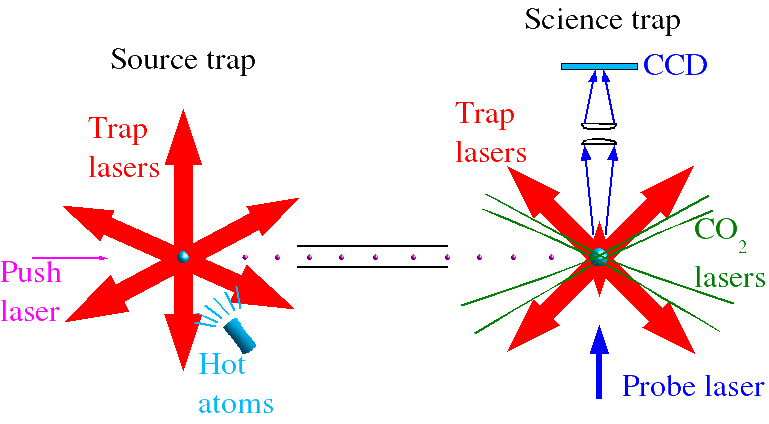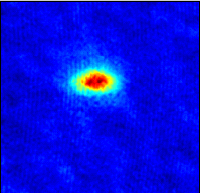The experiments we are conducting use lasers to slow down and trap rubidium atoms which have been released into a vacuum chamber. Making use of radiation pressure and the Doppler and Zeeman effects we are able to slow the atoms down and trap them in a ‘Magneto-optical trap’ (MOT), cooling the atoms to the equivalent temperatures of the order of 10mK above absolute zero. We then push these pre-cooled atoms across into our secondary chamber, the ‘Science trap’, which has a much higher vacuum of 8e-11 torr without the background vapour of hot atoms. Here, the atoms are again captured in a MOT, before they are transferred to a ‘dipole trap’, which is formed in the focus of a strong CO2 laser.
Our first aim is now to cool the atoms down further, closer to absolute zero. To that end, all resonant laser fields, i.e., trapping, pushing and probing fields, are turned off to avoid heating. Then the atoms are allowed to evaporatively cool, in a way similar to how coffee gets cold. The fastest atoms escape the trap, leaving the remaining atoms colder on average. Collisions between the trapped atoms then redistribute the remaining energy, and again the hottest atoms escape the trap. The trap walls are slowly turned down to accelerate this process. Eventually, in a tight trap, the quantum-mechanical motional states become apperant, and atoms condense in the lowest state of the trap, forming a ‘Bose-Einstein Condensate’ (BEC). The BEC forms the starting point of some new research, ranging from Quantum Computers to the answers to some fundamental questions about quantum-mechanics.
We can measure the temperature of the atoms by turning off the trap, and letting the atom cloud expand. Every atom will keep moving with the momentum it had when the trap was turned off, so its position after some time will be determined by this momentum. At that time, we take a snapshot of the atoms by absorption. We aim a “probe” laser beam, which is on resonance with the atomic transition, at the atom cloud, and measure the amount of absorption. Below is a typical absorption picture of a BEC after 10 ms time of flight.


